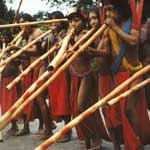
Zoomorphous
bench (armadillo), object for personal comfort, acquired from Loja Amoa
Konoya, 2000. |
A very beautiful side of
Beijing is revealed when you ascend the towering North Gate of the Palace Museum
and looks out towards Jingshan Hill, which is only five minutes' walk away.
With the palaces of the Forbidden City at your back, you see the canal
running beneath your feet, and cars, bicycles and pedestrians rushing to and fro
on Jingshan Qianjie street outside the red palatial wall - all of it seeming
like a vivid silent movie.
Across the street, at the foot of the green hill are rows of old houses and
courtyards.
The gate, which is called "Shenwumen," has been open to the public only since
last Tuesday, when the first exhibition given by a foreign country in the
Forbidden City kicked off in the tower above the gate.
Objects displayed above the gate are a sharp and interesting contrast to the
royal palaces which embody the monumental glory of Chinese architecture.
Titled "Amazonia: Native Traditions," the show features 344 traditional
artefacts made by past and present indigenous peoples of Amazonia, who have
lived in the rainforest for some 5,000 years.
It is jointly sponsored by BrasilConnects, a private non-profit entity that
organizes exhibitions in Brazil and around the world, and the Palace Museum.
The exhibition, which will run until August 24, is one of the most fabulous
shows to come to Beijing so far this year.
It is well worth a visit to those interested in Latin American culture.

Wajapi
Indians play at the local Jawaro Festival during the Jaguar ritual cycle
in Amapa State. |
The exhibition is
composed of two parts: archaeological finds, such as pottery from the areas of
Maraca, Guarita and Ariste; and modern Indian artefacts such as feather
ornaments and ceremonial masks.
Besides the carefully chosen artefacts, the show also boasts a wonderful
curating job, which is the result of in-depth and systematic research.
A major activity staged to celebrate the 30th anniversary of the
establishment of diplomatic relations between China and Brazil, the show has
received congratulatory messages from Chinese President Hu Jintao and Brazilian
President Luiz Inacio Lula da Silva, who visited China last week.
Lula and Chinese State Counsellor Chen Zhili presided over the opening of the
show on Tuesday.
"Through the exhibition, the Chinese will have an opportunity to get to know
something about the largest tropical forest in the world, with its rich
biodiversity and more than 170 indigenous peoples, who speak around 100
different languages," said the Brazilian President.
"Though concern over the future survival of the Amazon, the planet's lungs,
has reached every corner of the world, little is known about the peoples who
have lived in the Amazon forests for 5,000 years, and how they developed a rich
and complex interaction with nature, with practices, beliefs, myths and rituals
that have been maintained until today," said Edemar Cid Ferria, chairman of
BrasilConnects.
Actually Amazonia is today home to about 220,000 Indians, who live in the
so-called Legal Amazonia, an area essentially covered by forest in Brazil, said
Luis Donisete Grupioni, anthropologist with the University of Sao Paulo, who is
one of the two curators of the exhibition.
They live on 401 Indigenous Lands, with some degree of juridical recognition
by the Brazilian Government, and have a total protected area of more than 1
million square kilometres.
There are 46 other groups who do not have permanent contact with the rest of
Brazilian society.
As a general rule, Brazil's indigenous peoples are small in numbers, more
than half of the groups consisting of less than 500 people, said Grupioni.
These groups have an amazing linguistic and cultural diversity. Today 180
languages are known, distributed into 41 families in two major linguistic
branches, as well as other isolated languages.
The objects the people make embody ideals of beauty and perfection that go
far beyond the objects' functional requirements, said the anthropologist.
Visitors to the exhibition will be surprised to find how flourishing the
indigenous cultures have been in the rainforest, and how blind people have been
to the ancient civilization, which has been generally thought to be "primitive"
and "marginal."
"I hope Chinese visitors will learn from the art show the cultural diversity
of humanity, further understand the importance of protecting the global
ecological environment, and love the globe as the habitat of mankind as well as
the colourful cultures of humanity more than ever," said Chinese President Hu
Jintao.

